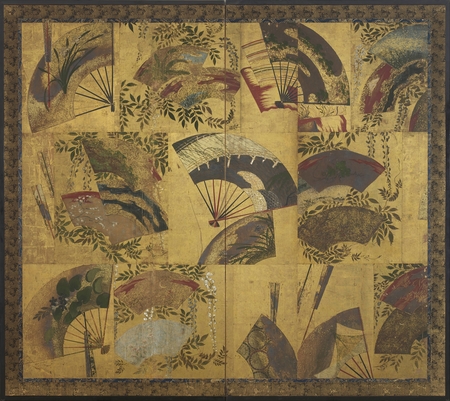Product Description
7321 A two-fold paper screen painted in ink and colour on a gold ground with numerous folding fans on a background of fuji (wisteria). They are depicted either open or closed and each one is lavishly decorated with an abstract design or traditional motif, which include seasonal flowers and famous locations such as Uji bridge and Miho-no-Matsubara (Miho pine grove).
Japan 17th century Edo period.
Dimensions: H. 67½” x W. 75¼” (171cm x 191cm).
The Japanese have decorated paper folding fans with paintings since at least the twelfth century, and the first folding screens to feature scattered fans appeared in the fifteenth century. It became popular around this time to paste or paint fans over a background of flowing water, a type of imagery that may have evolved from the medieval pastime of casting fans into a flowing river for a final appreciation of their beauty as they floated downstream when discarded at the end of summer.
A story that appears in the Ansai zui-hitsu (Essays by Ansai), a collection of essays on miscellaneous subjects by the antiquarian Ise Sadatake (1717-1784), suggests one explanation for this fashion. According to the tale, an Ashikaga shogun of the Muromachi period was on his way to the Kyoto temple of Tenrūji when one of his vassals accidentally dropped his master’s fan into the Ōi River from the bridge, Togetsukyō. Taking their cue from the vassal, all the other members of the shogun’s retinue followed suit and tossed their fans into the water.









